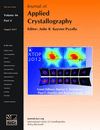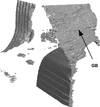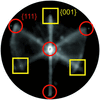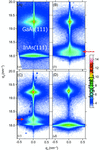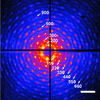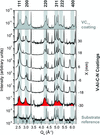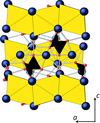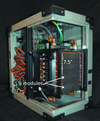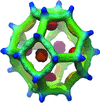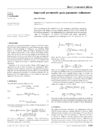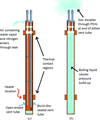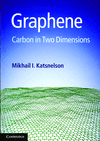issue contents
August 2013 issue

Cover illustration: Reciprocal space maps for a sample comprising GaAs nanowires grown on a (111)-oriented GaAs substrate {courtesy of Bussone et al. [J. Appl. Cryst. (2013), 46, 887-892]}, and in situ diffraction patterns measured during incremental heating of a colloidal crystal {courtesy of Zozulya et al. [J. Appl. Cryst. (2013), 46, 903-907]}.
editorial
Open  access
access
 access
accessThis issue of Journal of Applied Crystallography includes some highlights of the 11th Biennial Conference on High-Resolution X-ray Diffraction and Imaging (XTOP), held in St Petersburg in 2012.
X-ray diffraction and imaging
Open  access
access
 access
accessA three-dimensional Bragg diffraction imaging technique, which combines rocking curve imaging with `pinhole' and `section' diffraction topography in the transmission case, allows three-dimensional lattice distortion in the bulk of an ice crystal under compression to be measured.
Open  access
access
 access
accessThe microcrack propagation and cleavage behaviour in silicon wafers during thermal annealing has been studied by in situ X-ray diffraction imaging (topography).
Open  access
access
 access
accessA framework for linking image quality to radiation dose in order to optimize experimental parameters with respect to dose reduction is presented.
Open  access
access
 access
accessThree-wave diffraction has been experimentally studied for a set of III–nitride and ZnO epitaxial films differing in thickness and structural perfection. Properties of the multiple diffraction pattern in highly distorted layers are analyzed.
Open  access
access
 access
accessSelective epitaxial growth of Ge on nanostructured Si islands on silicon-on-insulator substrates is investigated by X-ray diffraction and transmission electron microscopy to prove the compliance effect between the materials and the structural perfection, especially under the use of a thin SiGe buffer layer.
Open  access
access
 access
accessThree-dimensional reciprocal space mapping by X-ray and electron diffraction [namely grazing-incidence X-ray diffraction (GIXD), reflection high-energy electron diffraction (RHEED) and grazing-incidence small-angle X-ray scattering (GISAXS)] was used to explore the internal structure and shape of differently oriented epitaxial Co/CaF2 facetted nanoparticles.
Open  access
access
 access
accessA combination of high-resolution X-ray diffractometry, Rutherford back scattering spectroscopy and secondary-ion mass spectrometry (SIMS) allowed the influence of structural transformations in the damaged layer of Zn-doped Si(001) substrates after a multistage thermal treatment to be revealed. The shape of the Zn SIMS profiles correlates with the crystal structure of the layer and depends on the presence of factors influencing the mobility of Zn atoms.
Open  access
access
 access
accessThe crystalline structure of single free-standing GaAs nanowires, grown by molecular beam epitaxy on a GaAs substrate at specific positions defined by focused ion beams, and the substrate regions close to the Au-implanted regions are investigated through grazing-incidence X-ray diffraction.
Open  access
access
 access
accessAn investigation of the influence of Si supply on the molecular beam epitaxy growth process and morphology of InAs nanowires grown on GaAs[111]B substrates is presented.
Open  access
access
 access
accessThis article reports the characterization of thin SiGe/Si(100) epilayers using reciprocal space maps measured by a laboratory X-ray instrument and a high-resolution X-ray diffraction study of partially relaxed SiGe/Si thin films.
Open  access
access
 access
accessThe results of a real-time X-ray crystallographic study of the melting transition of polystyrene colloidal crystals during heating are presented.
Open  access
access
 access
accessDip coating is a facile technique to control structure and electrical performance. Both structural anisotropy and transport properties are enhanced upon thermal treatment.
Open  access
access
 access
accessA modified version of the statistical dynamical diffraction theory has been applied to a set of model SiGe/Si thin-film samples in order to define the capabilities of this approach for returning structural information from defective semiconductor heterostructures.
Open  access
access
 access
accessA general theoretical approach to the description of epitaxial layers with essentially different cell parameters and in-plane relaxation anisotropy is presented.
Open  access
access
 access
accessThe nonlinear continuum equation of thin-film growth is applicable to simulate the surface of multilayer gratings with large boundary profile heights and/or gradient jumps. The integrated approach to the calculation of boundary profiles and the intensity of short-wave scattering by multilayer gratings is a way of performing studies comparable in accuracy to measurements with synchrotron radiation for known materials and growth techniques.
Open  access
access
 access
accessProcessing of phase-contrast images in laboratory conditions is described.
Open  access
access
 access
accessHigh-quality quartz (α-SiO2) crystals are characterized, and their use for inelastic X-ray scattering analyzers is presented and discussed.
Open  access
access
 access
accessSeveral ways of tuning a higher asymmetry factor (>10) in V-channel X-ray monochromators, for metrological and imaging applications, were analysed. A more than sixfold intensity increase for compositionally and thermally tuned cases was achieved.
research papers
A stack of Si curved crystals has been characterized under hard X-ray diffraction. The stack behaves as if it were a single crystal as a result of diffraction by curved diffracting planes.
Two conceptually different methods to representatively reduce large experimentally measured orientation data sets are derived and discussed. Examples are given which show that, with approximately 3% of the experimental data, the crystallite orientation distribution can be very well reproduced.
Flax cellulose forms long fibres called microfibrils, a few micrometres in diameter. Lateral disorder in flax microfibrils was partitioned into multiple components by successively removing the contribution of each component from the equatorial profile of wide-angle X-ray scattering.
A new class of polyurethane and poly(urethane–urea) materials based on heterocyclic and aromatic chain extenders were developed. A morphology study revealed the presence of phases with sharp phase boundaries and patterns that are best fitted with a model consisting of liquid-like ordered polydisperse spheres.
A large single crystal of L-tartaric acid was grown using a home-built crystal growth setup. The crystal was characterized using single-crystal X-ray diffraction, high-resolution X-ray diffraction, and IR and UV–Vis–NIR spectroscopy.
A method is presented for the calculation of the pair distribution and structure factor functions from area detector measurements of the X-ray scattered intensity for an off-center incident X-ray beam on an amorphous spherical sample.
A new method is suggested for estimation of the structure factor for nonspherical hard bodies, using the structure factor for a size distribution of spheres. The size distribution should be chosen such as to give good agreement between the two excluded volume distance distributions for the objects.
The zeolite-specific structure solution program FOCUS has been modified to work with three-dimensional electron diffraction data. The method was applied successfully to five different zeolite materials using data sets collected with either automated diffraction tomography or the rotation electron diffraction technique.
Dynamical diffraction theory was used to simulate reflection high-energy electron diffraction intensity variations during the perfect layer-by-layer growth of germanium.
Open  access
access
 access
accessA novel 2π detector geometry for small-angle neutron scattering (SANS) applications is presented and its theoretical performance evaluated. The shape of the detector is inspired by an optimization process based on the properties of the conversion material. Advantages over the detector geometry traditionally used on SANS instruments are discussed.
The fabrication and testing of a prototype deep-depletion X-ray CCD are described. Calibration measurements and the results of initial protein crystallography experiments are described.
Ball milling of a coarse powder and co-precipitation of CaCl2 and NH4F were employed to produce two nanostructured fluorites with comparable domain size but drastically different defect concentration. The combined use of X-ray diffraction line profile analysis and solid-state NMR shows the effects of inhomogeneity in the milling process and clearly points out the different effect of lattice defects on the NMR spin-lattice relaxation.
A low-cost CCD detector that is read out while scanned can provide resolution approaching that of a best-in-world analyzer-crystal detector, while offering data collection speeds and sensitivities much closer to those of a large-area detector.
Open  access
access
 access
accessV–Al–C–N hard coatings with high carbon content were deposited by reactive radio-frequency magnetron sputtering from a segmented sputter target. The composition-dependent coexisting phases were analysed using the complementary methods of X-ray diffraction (XRD), X-ray photoelectron spectroscopy (XPS), X-ray absorption near-edge spectroscopy (XANES) and extended X-ray absorption fine-structure spectroscopy (EXAFS).
β-FeSi2 flat islands have been fabricated on ultra-thin oxidized Si(111) surfaces by Fe deposition on Si nanodots. The microstructure and interdiffusion behaviour of the β-FeSi2/Si(111) system at the atomic level were studied by using spherical aberration-corrected high-angle annular dark-field scanning transmission electron microscopy and energy dispersive X-ray spectroscopy.
Download citation


Download citation


A new mechanism of heterovalent anionic substitution was revealed in fluoride borates when a [(BO3)F]4− tetrahedral group is replaced by four fluoride anions. No exception to this mechanism has been discovered among all known phases with formal (BO3)3− ↔ 3F− substitution.
Download citation


Download citation


Structural investigations under temperature variation were carried out on SrLaMRuO6 (M = Zn and Mg) double perovskites using diffraction techniques and a symmetry-mode analysis approach. The temperature versus tolerance factor phase diagram was completed for SrLnMRuO6.
Download citation


Download citation


The crystal structure of a novel open-framework gallogermanate, SU-66, has been solved from laboratory X-ray powder diffraction data in a direct-space structure solution algorithm by using local structural information obtained from infrared spectroscopy. The method appears to be generally applicable to other open-framework germanates.
Pair distribution functions obtained from electron diffraction and molecular dynamics simulations were used to analyse the evolution of short-range order in amorphous-to-crystalline phase transformation of MgF2. It was concluded that the metastable CaCl2-type MgF2 phase is stabilized by intergranular strains.
It is shown that a combination of the new beamline P02.1 at PETRA III (DESY, Hamburg) with a new cell design exhibits outstanding conditions for in situ battery characterization, even for low-symmetry complex crystal structures. Crucial points like instrumental resolution, available q range and measurement time per pattern for excellent counting statistics are investigated. It is demonstrated that the latter can be reduced to the region of milliseconds.
The geometric distribution of Mn active centers during Faradaic reaction was quantitatively calculated on the basis of four different kinds of MnO2 crystallographic structures, which can be confirmed by our experimental supercapacitance evaluations of these four kinds of MnO2 samples.
The algorithm presented in this paper recognizes an investigated semicrystalline polymer by analyzing the shape of its X-ray diffraction curve. This allows an easy and fast preparation of the starting parameters in the optimization procedures used for decomposition of the curve into crystalline peaks and amorphous component, which is the most important step in polymer crystallinity determination.
Open  access
access
 access
accessCorresponding two-dimensional grain maps from the diffraction contrast tomography and electron backscatter diffraction characterization methods were aligned and compared, focusing on the spatial resolution at the internal interfaces. The compared grain boundary networks show a remarkably good agreement both morphologically and in crystallographic orientation.
The diffraction response of a single crystal subjected to an in situ electric field periodically reversed is recorded with an XPAD large-area hybrid pixel detector. This new approach to the field-switching method offers unprecedented perspectives to analyse the electric field-induced structural deformations.
Open  access
access
 access
accessAlgorithms for the reciprocal space conversion of linear and area detectors are implemented in an open-source Python package.
This versatile technique allows for the rapid computation of scattering profiles from atomic structures. Using four macromolecules as examples, it is demonstrated how this method is faster and more reliable than the standard multipole expansion method.
The effect of microvoids on the performance of aramid fibers was revealed by two-dimensional small-angle scattering and full pattern fitting.
A new program is presented that allows efficient evaluation of comprehensive one- and two-dimensional small-angle scattering data series. Furthermore, various anisotropy measurement methods are explained and compared with each other.
CRAFS is a Rietveld model tailored for X-ray diffraction analysis of plant cellulose. With consistent treatment of diffraction peak overlapping and crystallite texture, CRAFS parameterizes cellulose fine structure across wide spectra of specimens.
Single-crystalline Ni–W shards exhibit a peculiar ordering behaviour. This order causes the entire skeleton of the first Brillouin zone to be illuminated from diffuse scattering intensity under synchrotron radiation.
short communications
Phase determination of the crystal structure factor by measuring rocking curves from a polar crystal
A novel phase determination approach comparing FWHMs with intensities of rocking curves from the top and bottom surfaces of a polar crystal is proposed. This approach is potentially very useful for determining the phase of a polar crystal, including that for a nearly perfect crystal.
Reworked expressions for the derivatives of parameters describing powder peak axial asymmetry lead to improved behaviour when modelling powder patterns.
computer programs
The program GBgeom can simulate the geometrical arrangement of unrelaxed atoms at the grain boundary planes of cubic crystalline materials and can illustrate the various texture representations in a single window.
A software package for the three-dimensional modelling of dose distributions in macromolecular crystals during X-ray diffraction experiments is described.
EXPO2013, the latest version of the EXPO suite, has been enriched with new phasing approaches and with novel computing and graphic tools.
laboratory notes
A two-stage solution has been implemented on top-loading cryo-furnaces to alleviate the safety implications involving icing up of the sample space.
book reviews
Free 



 journal menu
journal menu








